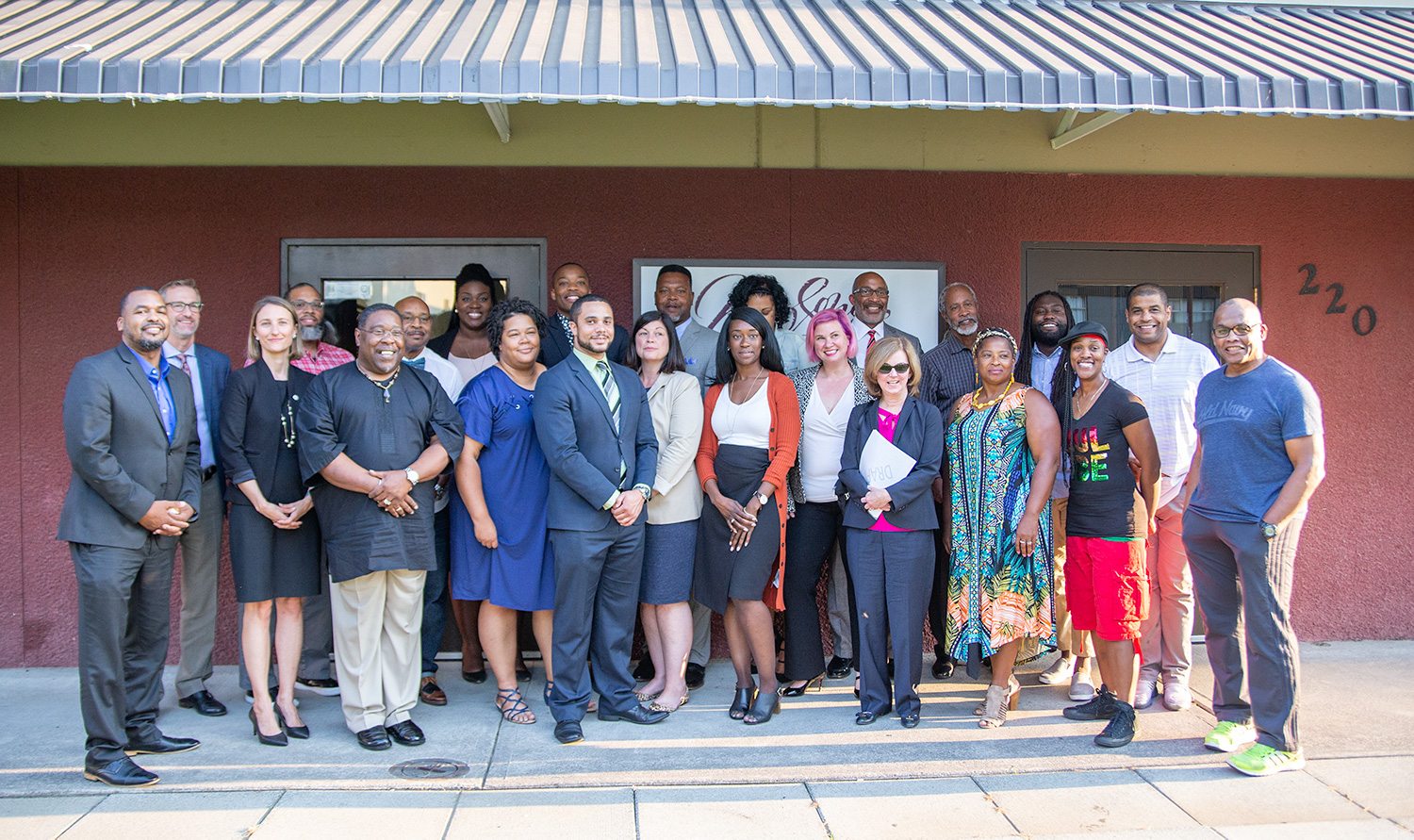Proposed Upgrades to Building and Tracks
Preliminary Engineering and Environmental Review
Portland’s Union Station is the oldest major passenger terminal on the West Coast. Construction began in 1890; it opened for service in 1896 and has been in continuous operations since that time.
Portland’s Union Station is the oldest major passenger terminal on the West Coast. Construction began in 1890; it opened for service in 1896 and has been in continuous operations since that time. There was a significant renovation and modification to the original waiting and passenger service areas completed during 1927-30. During the World War II era, a small nursery addition was constructed on the track side of the station for mothers and their children. Since 1945, there are multiple known changes to Union Station, but the station looks much like it did in the 1930s. However, the track yard, including platforms and canopies, has been serially modified over the station’s history in response to changes in passenger rail needs. In 1975, Union Station was listed on the National Register of Historic Places. Prosper Portland (previously known as the Portland Development Commission) acquired Union Station in 1987. The station has four existing tracks and two passenger platforms, owned by Prosper Portland and in regular use by Amtrak passenger trains. One mainline track is owned by Portland Terminal Railroad Company (PTRR) used mostly for freight trains.
Union Station is on the U.S. Department of Transportation’s Federal Railroad Administration (FRA)-designated, 466-mile Pacific Northwest Rail Corridor that extends from Eugene, Oregon to Vancouver, British Columbia. Union Station is currently serviced by 10 daily passenger trains for Amtrak’s Cascades, Coast Starlight, and Empire Builder routes.
Over the last ten years, several critical repair and maintenance projects have been completed at Union Station including: in-kind replacement of the metal roof tiles, gutters and downspouts; partial seismic stabilization; and the repair and/or in-kind replacement of windows and doors. Additional repairs are needed to stabilize and rehabilitate Union Station.
In late 2010, the Oregon Department of Transportation (ODOT) was awarded a grant under the FRA High-Speed Intercity Passenger Rail Program to complete Preliminary Engineering and analysis of potential impacts to the human and natural environment in accordance with the National Environmental Policy Act (NEPA) to support future final design and construction of track and building upgrades at Union Station. The NEPA process includes analysis of impacts under other federal requirements, such as Section 106 of the National Historic Preservation Act. Prosper Portland is the subrecipient, through ODOT, of these federal funds.
Through a competitive RFP process Prosper Portland selected three consultant teams with a wide variety of expertise to complete a thorough conditions assessment, guide the creation of the alternatives considered, develop the proposed project and complete the environmental review. Recognizing the importance of maintaining the historic integrity of Union Station, the Prosper Portland team entered into a robust review process with the Oregon State Historic Preservation Office (SHPO), which started during the conditions assessment and through conceptual design and development of the proposed project.
Prosper Portland, in partnership with ODOT, is proposing to modernize Portland’s Union Station to meet current code standards, and future (year 2035) passenger rail demand based on the Washington State Department of Transportation’s (WSDOT) Long Range Plan for Amtrak Cascades and the Amtrak ridership forecasting developed for the Oregon Corridor Investment Plan. Preliminary design work for the proposed project is receiving federal grant funds from the FRA; construction of the proposed improvements is currently unfunded. Prosper Portland and ODOT are preparing an evaluation of the proposed changes to the building and tracks to assess the potential impacts of the proposed project to the human and natural environment. This evaluation will be prepared in accordance with the FRA’s procedures for considering environmental impacts, Section 106 of the National Historic Preservation Act (NHPA), regulations issued by the Advisory Council on Historic Preservation, and NEPA.
Union Station Building, Annex, and Canopies
- Seismic upgrades throughout building, including clock tower and chimneys
- Modifications to building, elevators, and stairwells to meet current, applicable codes, including Building, Fire/Life/Safety, Structural, and Energy codes, and Americans with Disabilities Act (ADA) accessibility requirements to improve accessibility for people with disabilities and improve emergency egress
- Reorganization of first level floorplan to
- Minimize circulation conflicts between arriving and departing passengers
- Increase efficiency and accessibility of ticketing, baggage and passenger service areas
- Repurpose ticketing counter into retail concession area
- Refurbish south concourse area
- Remove the nursery addition (beyond repair due to damage from water and mold)
- Improve accessibility, layout and amenities for leasable offices spaces on upper floors
- Modernize building’s heating, cooling, electrical, and plumbing systems
- Replace canopies to meet current structural, accessibility, and rail design requirements
- Renovate annex building with seismic improvements, modernized heating, cooling, electrical, and plumbing systems, and other code required upgrades for commercial re-use
Site
- Remove annex parking lot
- Convert area near annex into a public plaza
Railroad Tracks and Platforms
- Update Tracks 1-4 rails, ties and ballast and replace existing old or broken platform equipment
- Improve and modernize the train signal and communication systems
- Relocate the passenger crossing to accommodate the forecasted increase in passenger trains at Union Station
- Replace platforms to meet current rail design standards and improve access for persons with disabilities
- Upgrade platform utilities, including water, communications, compressed air and electrical systems, that serve passenger trains
- Improve roof/gutter and stormwater management systems for new platforms and canopies
- Install a new train re- fueling system and replace old track pan system for oil/fuel containment from locomotives
- Improve yard track crossings to facilitate Amtrak baggage and maintenance operations
- Rebuild Track #6 east of the existing Track #5 for freight rail movements around Union Station
- Install new track north of the NW 9th crossing to facilitate train movements and required train inspections
- Site changes would accommodate increased train movements to and from different tracks within the station and north of NW 9th Avenue necessary for the planned increase in Amtrak Cascades service by the year 2035
Portland Union Station Building and Tracks Improvements
Programmatic Agreement to Resolve Adverse Effects on Historic Properties
Prosper Portland, in coordination with the Oregon Department of Transportation (ODOT) and the U.S. Department of Transportation’s Federal Railroad Administration (FRA), is proposing improvements to modernize Portland’s Union Station. The station is a historic property listed on the National Register of Historic Places. The goal of the modernization improvements is to meet current building code, life-safety, and seismic standards and to accommodate current and future intercity passenger rail demands (the Project). The Project includes phased improvements to the existing Union Station buildings, the High Shed, the platforms and canopies, and the adjoining track infrastructure. Union Station is located at 800 NW 6th Avenue. The Project area proposed for improvements extends from Union Station south to approximately NW Naito Parkway and north from Union Station to NW 15th Avenue.
ODOT is receiving federal grant funds from FRA, and Prosper Portland is a subgrantee to ODOT, responsible for completing the preliminary design work and an environmental review to assess potential impacts to the human and natural environment that may result from the Project. Currently, no funding has been identified to advance the Project through final design and construction.
As part of the environmental review, Prosper Portland, ODOT, and FRA are evaluating the proposed Project to assess potential adverse effects on historic properties. The environmental evaluation is being conducted in accordance with federal procedures and regulations including the National Environmental Policy Act (NEPA), Section 106 of the National Historic Preservation Act of 1966 (NHPA), as amended, and its implementing regulations at 36 CFR Part 800 (Section 106), and Section 4(f) of the US DOT Act of 1966.
Section 106 requires federal agencies to consider the effects of projects they carry out, assist, fund, permit, license, or approve on historic properties. Through the Section 106 review process for the Project to date, FRA has determined, and the Oregon State Historic Preservation Officer (SHPO) has concurred, that the Project, if constructed, would have adverse effects on four historic elements of Union Station: the Front Yard, the High Shed, the platform canopies, and the Nursery. Prosper Portland, ODOT, and FRA have consulted with interested parties to identify measures that could be used to resolve the adverse effects of the Project on the historic elements of Union Station. The proposed measures are incorporated into a draft Section 106 Programmatic Agreement which will be executed among FRA, SHPO, ODOT, and Prosper Portland and which will guide the Project, in terms of consideration of the historic significance of Union Station, as the Project advances over the next 10 years.
Additionally, the Section 106 process provides the public with the opportunity to review and comment on the draft Programmatic Agreement. This process is an important way for residents to lend their voices in protecting and maintaining historic properties in their communities.
From September 30 – October 30, 2019, Prosper Portland, ODOT, and FRA collected feedback regarding the process and the proposed measures to resolve adverse effects that are outlined in the draft Programmatic Agreement. Feedback received will be considered in preparing the final Programmatic Agreement, which is scheduled to be executed in the Spring of 2020.
You can review the draft Programmatic Agreement below:
STAY INFORMED
Join our email list for Union Station Project updates.
SEND AN EMAIL
If you have additional questions about the proposed project send an email to the project team: UnionStation@prosperportland.us
Document Library
The following project reports are available through this website and hard copies are also available for review at Prosper Portland, 222 NW 5th Avenue, Portland, Oregon, 97209.

